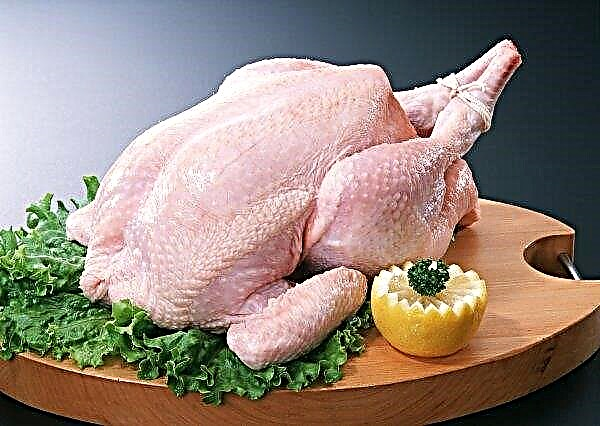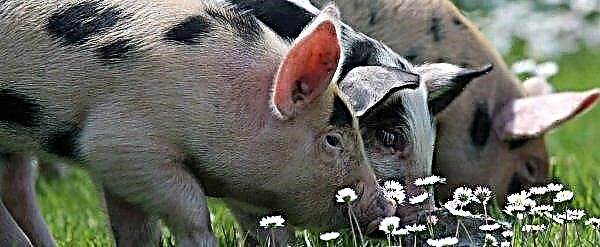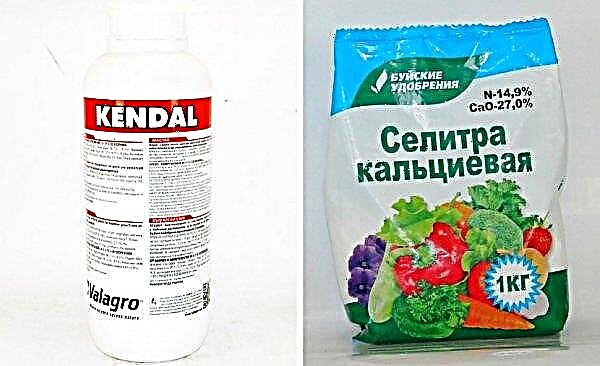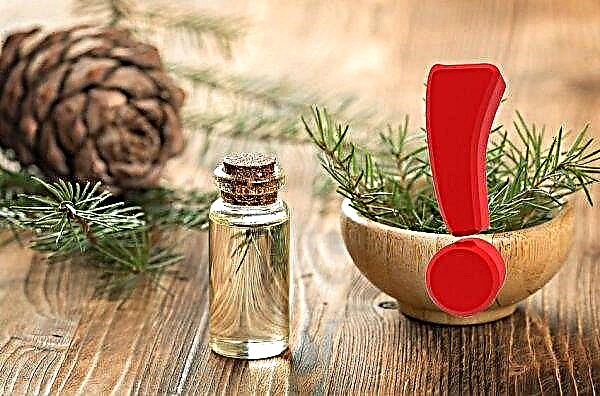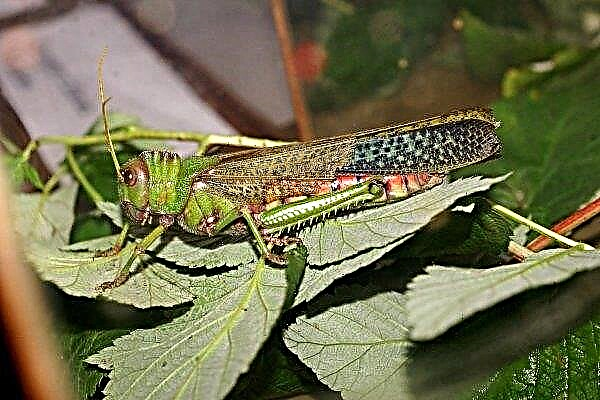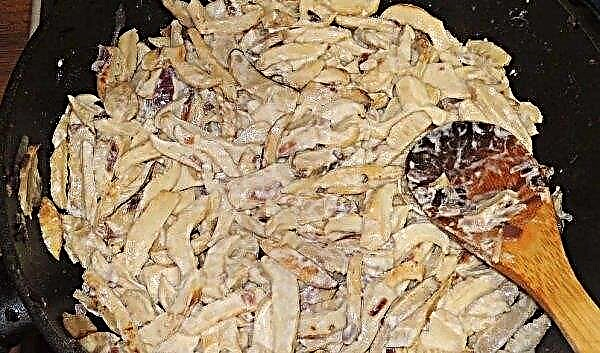Everyone who was engaged in cattle breeding with the aim of obtaining dairy products is familiar with mastitis. This diagnosis brings a lot of problems, so it is important to know how to identify it and how to cure it in order to minimize the waste of milk and money - more on this later in the article.
What is mastitis in a cow
One of the most common diseases in livestock farming of the dairy direction is mastitis. Appears against the background of some complications after childbirth, which are supplemented by problematic care and feeding. Violations affect the udder at the level of glandular tissue. General symptoms are presented:
General symptoms are presented:
- health problems;
- decreased productivity
- fever;
- the appearance of foreign clots in the products;
- soreness and anxiety during manual milking.
Did you know? Cows have a well-developed sense of time: for example, a late milkmaid for half an hour reduces milk yield by 5%, and the fat content of the product - by 0.4%.
Causes of occurrence
Inflammation of the udder can develop both during the period of feeding the offspring, and before starting, and during dryness. The most common cause is an attack of microorganisms while reducing the body's resistance.
In addition to the development of mastitis contribute to:
- Injury to the udder. Problems in the form of microcracks can occur with any bumps or shocks, and even when using milking equipment.
- Bad cows. This is especially true immediately after calving or the start of milking. It is important to monitor the fullness of the milking and not to leave even a small amount of milk in the mammary gland.
- Unsanitary conditions. It is necessary to create optimal conditions in the room where the animal lives - to change and disinfect the litter in time so that the bacteria do not have the opportunity to multiply. In addition, the hands of milkmaids and equipment must be clean so that the infection does not get during milking.
- Reproductive system diseases. The problem appears as a side effect of other diseases and manifests itself as inflammation of the mucosa.
- The presence of unnecessary amounts of different concentrates in the feed. When special substances are added to increase milk yield, the udder can begin to swell.
- Incorrect or delayed treatment. Poor quality drugs reduce the effectiveness of treatment, which leads to complications. A neglected condition is much more difficult to cure.

Forms and signs of mastitis in a cow
From the clinical side, mastitis is divided into the types described below.
Important! If even one symptom appears, urgently need to contact the veterinarian for advice and full assistance.
Serous
A similar form occurs after an injury or violation during milking.
Mastitis is manifested by the following symptoms:
- damage to only one part of the udder, its increase;
- temperature increase;
- swelling and tension of the skin of the udder;
- breast overflow;
- soreness when feeling;
- an increase in the size of indented lymph nodes;
- decrease in the quantity and quality of milk;
- refusal of feed.
Catarrhal
This species is manifested by internal inflammation. It develops after receiving mechanical injuries of the nipples and has the following symptoms:
It develops after receiving mechanical injuries of the nipples and has the following symptoms:
- the first milk during milking is very liquid;
- flakes and non-specific clots precipitate;
- clogged nipple with curd consistency liquid;
- nipple seal;
- the presence of sufficiently dense nodes in the udder.
Fibrous
It develops as a complication of previous mastitis or as a transition to the stage of purulent pericarditis.
Symptoms are as follows:
- decrease in milk yield;
- from the nipple get a few drops mixed with protein;
- the affected share is increased;
- temperature increase;
- pain on palpation;
- enlarged lymph nodes.
Purulent
It develops as a result of the lack of a full treatment for inflammation with the presence of streptococci.
Signs are:
- reduction in the amount of milk;
- milk from the affected share of the bitter taste;
- udder reddish, hot to the touch;
- puffiness of the skin;
- soreness during milking;
- body temperature is at around 41 ° C;
- tuberosity of the skin of the udder;
- the presence of cereal in milk;
- abscess of the udder;
- the presence of pus.

Hemorrhagic
Inflammation of the udder, which proceeds in an acute form. Often it is preceded by catarrhal or serous mastitis. This can happen with a decrease in immunity, poor hygiene, improper milking, trauma and the presence of microtraumas. The onset of the disease occurs sharply, inflammation covers most of the udder.
Did you know? The popular sign says: if cowsand eats in the evening a lot of while drinking herbs few water, then in the morning it will rain.
In addition, other signs appear:
- swelling of the udder;
- crimson spots are visible on the skin;
- the animal behaves extremely restlessly;
- intense heat.
Important! A distinctive feature is the acquisition of a yellowish mucosa. This happens due to the loss of a large number of red blood cells.
Subclinical
The most dangerous species, as it is hidden and is accompanied by a sluggish inflammation with subtle signs. When milking with machines, similar problems are diagnosed in 15% of cows that are in lactation. The reasons for hidden mastitis are varied. The disease is diagnosed by the presence of the following symptoms:
The disease is diagnosed by the presence of the following symptoms:
- upset breast function;
- changes in the biochemical qualities of milk.
Colimastitis
This form is quite difficult to cure.
Symptoms are as follows:
- rapid weight loss;
- dehydration;
- cessation of lactation;
- temperature increase up to 42 ° С;
- general oppression.
Diagnostics
To detect mastitis, you need to take milk for analysis. Do it monthly, starting almost immediately after the calf is born. It is more correct to carry out this in the laboratory, however today there is the possibility of diagnosing at home.
At home, it is carried out using a Dimastin solution (5%) and milk control plates (MKP-1 and MKP-2). 1 ml of milk is pumped into each cell with different shares of the udder: the first drops are unsuitable, as they may contain bacteria. The drug is added to each sample and stirred. They wait about 15 minutes and detect the presence or absence of the disease.
The drug is added to each sample and stirred. They wait about 15 minutes and detect the presence or absence of the disease.
Pay attention to the following conditions:
- homogeneity is the norm;
- traces of “jelly” - a weakly positive result;
- clots - a positive result;
- red shade - the presence of pathology;
- orange color is the norm.
What to do: how and how to treat
Knowing how to determine the disease, it is recommended to obtain information on treatment in order to know how to act in this situation.
When the cow is in this condition, it needs to be milked by hand every 3 hours - this allows you to protect the udder from the appearance of blood clots. In addition, the udder is washed with cool water several times a day. Feed the animal only with dry food, while limiting drinking.
Antibiotics
Any inflammatory process is treated with antibiotics. The drug is injected into the affected area using a catheter. Most often, therapy takes 4 days.
The most effective drugs are as follows:
- "Masticide";
- Penersin;
- "Mastisan-A."
 Chronic mastitis is most often treated surgically, removing all affected areas.
Chronic mastitis is most often treated surgically, removing all affected areas.Important! Timely detection with the right treatment, as well as ongoing prevention will help minimize the risk of disease and complications.
Folk remedies
Some types of mastitis can be treated without the involvement of specialists. Consider how to get rid of the problem with folk remedies. The udder is washed with heated water with salt or a nettle-based decoction. At the end of the squeezing, lightly massage the densified areas, doing this from top to bottom to remove pus.
Catarrhal and fibrous mastitis are treated with clay applications. The solution is prepared from white clay and a decoction based on nettles or plantain. The components are mixed and applied to the udder. The application is left all night, and in the morning they are removed with a heated nettle broth. Such actions remove swelling and anesthetize.
Hemorrhagic mastitis is removed by manual milking to prevent the appearance of blood clots. An ointment based on camphor is rubbed into the udder, the animal is given boric acid.
In addition, folk recipes imply different warmings. At 0.5 liters of water add 1.5 tbsp. tablespoons of vinegar, mix until smooth and make a compress. After 4 days, compresses are made of warm paraffin. Warming with a quartz lamp is also useful, after which the sore spot is insulated.
Can I drink milk from sick animals
During the acute phase, it is strictly forbidden to consume milk from sick animals. This can only be done 2 weeks after the treatment. In addition, the products can not be used for feeding young animals.
Did you know? To produce 1 liter of milk, a cow will need 4-5 liters of water.
Prevention
Any disease is easier to prevent than to treat further. During deadwood before calving, it is recommended to vaccinate with Mamifort Sekado, which contains cloxacillin and ampicillin trihydrate. Apply the drug for a month.
In addition, the following preventive measures are recommended:
- feeding animals with quality food;
- hygiene and systematic cleaning of the premises;
- regular examinations by a professional veterinarian;
- careful handling of the udder during milking;
- regular pumping followed by iodine disinfection;
- udder massage.
 From the foregoing, we can conclude that mastitis is a fairly serious disease that requires complex measures to improve the condition of the animal. However, it is better to do everything to prevent it, and thus save not only time, but also money.
From the foregoing, we can conclude that mastitis is a fairly serious disease that requires complex measures to improve the condition of the animal. However, it is better to do everything to prevent it, and thus save not only time, but also money.


